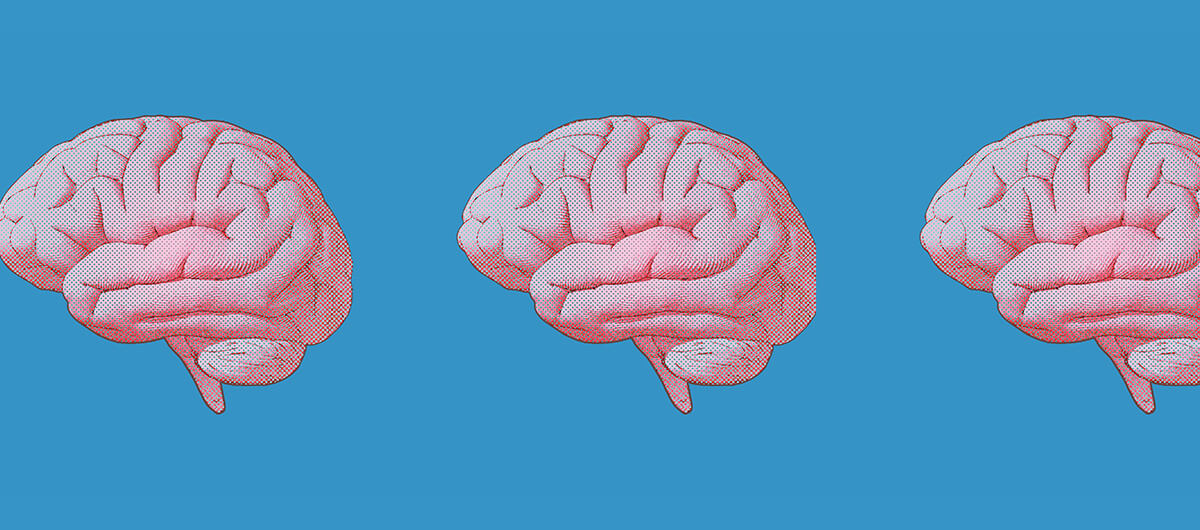

psychology
How Our Brains Rationalize ‘Normal’
How do we settle into a routine when all routine is lost? The answer lies in how our brains process disruption.
This article was made possible because of the generous support of DAME members. We urgently need your help to keep publishing. Will you contribute just $5 a month to support our journalism?
Imagine Americans are on a runaway train. We were going about our individual days—traveling for work, heading home from school, or running late for a date—and then suddenly here we all are, collectively looking out the window, questioning how we got on this train in the first place and why we’re now traveling too far, too fast. There are five workers up ahead on the tracks who will die if the conductor doesn’t take action. He has the power to move to a different set of tracks, though that decision comes at the cost of one other worker’s life. Do you want our conductor to change paths?
This thought experiment known as the trolley problem has been a fixture of ethical debates for the better part of the last century, shaping our perception of right and wrong. Prominent psychologists have used the dilemma to debate utilitarianism versus deontological ethics, frequently swapping out characters and circumstances to complicate the scenario, and therefore the moral decision-making, of their subjects. Our train is speeding through pandemic-stricken America. And the decision-making of our conductors is so full of inconsistencies, communication mess-ups, misinformation, and flat out lies that arguably, it’s a struggle to draw clear conclusions about the ethics driving the U.S. coronavirus response.
The result has brought Americans into a phase of seemingly endless uncertainty. As the death toll mounts, unemployment soars, and social distancing works its way into every conversation, what comes next is anybody’s best guess. Yet amid all the abnormality that’s entered our lives since March, we’ve dubbed this phase “the new normal.” Precautions, like masks and school closures, previously thought to be unreasonable or over-reactive are now socially expected. We’re attending weddings on Zoom and rediscovering home cooking against a backdrop of an unprecedented, once-in-a-generation global crisis. In the absence of our baseline normal, we’ve somehow recalibrated to make the once unthinkable, normal. How? And more importantly, why?
Our willingness to accept shifts in our regularity is rooted in how human brains normalize behaviors and circumstances in general, explains Joshua Knobe, professor of cognitive science and philosophy at Yale University. “What’s normal to do isn’t necessarily what’s considered right or wrong, but whether other people around us are doing it,” he says. What is normal, therefore, is what is considered frequent, and what is abnormal is infrequent. If no one around you at the grocery store is wearing masks, it’s infrequent, even though it’s been proven to slow the spread of the virus. “If no one is doing it, it becomes more abnormal, which can give you the profound sense that something is wrong if you behave differently,” Knobe says.
To avoid feeling “wrong,” people have a systematic tendency to focus on the possibilities they see as normal and ignore the ones they see as abnormal. In a 2017 study published in the journal Cognition, Knobe along with researcher Adam Bear found that “people’s representations of what is normal were influenced both by what they believed to be descriptively average and by what they believed to be prescriptively ideal.” In other words, our brains define normal as a blend of statistical and moral notions, a combination of what we sense is typical and what we sense is ideal, they wrote. Health experts have capitalized on this behavior to gain public support and participation in measures proven to slow the coronavirus’s spread. Statistically, they explained, the virus will continue to infect, hospitalize, and kill a percentage of the population likely until there is a vaccine, but morally, the number of infections and deaths can be limited by practicing social distancing, wearing face masks, and complying with closures of businesses, parks and beaches, schools, and workplaces. In this case, our tendency to normalize based on averages and ideals plus the frequency of our actions resulted in some good: though stretched thin, we avoided destructively overburdening the health care system—at least for this wave of infections.
People want to feel good about their lives and the decisions that shape them. This makes normalizing an emotionally driven choice. Individually and culturally, we land on a reference point, a mental marker for our brains to assess the normalcy of our lives. This point is what is typical, and depending on the stimuli we observe in our communities, plus our read of average and ideal, it moves. In mid-April, for instance, it was typical for more than 2,000 Americans to die each day from Covid-19. That’s in the ballpark of the 9/11 death toll—happening most days through the pandemic’s first peak. By that comparison, things are very bad. But choose a different reference point, such as yesterday or last week, and if deaths are decreasing, we can decide it is a good day, which makes us feel positive about our efforts.
What’s unprecedented now is just how many people’s reference points are shifting at any given moment. Our old standard norms are completely breaking down as a result, and whatever we do in their place becomes the new normal. “We have been thrust into a very strange, surreal new world,” says Robert Neimeyer, Ph.D., director of the Portland Institute for Loss and Transition. “Unfortunately, it’s one where we’re being marinated in loss.”
The official death toll is “just the tip of the iceberg” in terms of the loss we’re feeling, Neimeyer says. The fact that we’re universally contending with a virus that has brought unpredictability into all lives makes it a shared experience, but one that has mental health and emotional consequences we’re woefully unprepared to deal with, Neimeyer warns. “The new normal may be the new abnormal for how we grieve,” he says. “We have lost the opportunity to ritualize loss, which allows for a parting on better terms.”
Our rituals are our norms. Everything from our commute to funerals, Sunday church services to AA meetings are rituals with a built-in community that helps us to mentally and emotionally establish our reference points. With much of that baseline gone, what we build in its wake is then, a new normal.
There’s no definitive reason why humans choose “the new normal.” Neimeyer references how humans have evolved to need and value attachment. He says even in times of distress, we can get creative to feel close to the people we love. Knobe’s work has noted that if something has entered our conscience, it has the potential to become normalized. So in a way, as news about the pandemic changes daily, we’re in a constant state of normalizing. Cognitive scientists use upward and downward counterfactuals to understand our interpretations of these shifting norms are good or bad or somewhere in between. Counterfactual thinking is exploring “What if…” scenarios; the imagining of possible alternative outcomes of a particular life event. Upward counterfactuals imagine better outcomes than the reality; downward counterfactuals focus on how things could be much worse than they actually are.
“The struggle within our minds is that there’s something that really makes us want to think about how things could have been better or reflect back to how they used to be,” Knobe says. “But at the same time, there’s something really upsetting about thinking of how things were a year ago, or even a few months ago, compared to now. Yet, that option draws us in.”
The framing of our new normal through the pandemic exists within this mental struggle of weighing our desired scenarios with the public health realities. Lean too heavily in the direction of upward counterfactual thinking—a world in which we all go back to work and school without risk and no major changes have been made to our social and health safety nets—and we could face uncontrollable outbreaks, more death and despair. Many critics of President Donald Trump’s eagerness to reopen have called it magical thinking. Though commit to downward counterfactual thinking—where everything gets worse when we return to our old normal—and our country stays closed with millions out of work and economic turmoil growing permanent, though maybe less people die.
Health experts and cognitive researchers alike have explained that neither extreme is realistic. Rather, our new normal going forward will be a dance with the virus, one that will have an ever-moving reference point. The complications with this, however, arise from the polarity of U.S. politics and the federal government’s inability to adequately prepare for the next dance move. Behaviors and policies liberals would like to be normalized are at direct odds with the goals of their conservative counterparts, and vice versa. But even if there is no clear, unified plan to end the American coronavirus outbreak, we’re not condemned to normalize that, too. We are capable of distinguishing the difference between what is typical from what we deem acceptable. Perhaps choosing to counter those norms of the pre-pandemic world will make for a better new normal to come.
Before you go, we hope you’ll consider supporting DAME’s journalism.
Today, just tiny number of corporations and billionaire owners are in control the news we watch and read. That influence shapes our culture and our understanding of the world. But at DAME, we serve as a counterbalance by doing things differently. We’re reader funded, which means our only agenda is to serve our readers. No both sides, no false equivalencies, no billionaire interests. Just our mission to publish the information and reporting that help you navigate the most complex issues we face.
But to keep publishing, stay independent and paywall free for all, we urgently need more support. During our Spring Membership drive, we hope you’ll join the community helping to build a more equitable media landscape with a monthly membership of just $5.00 per month or one-time gift in any amount.




















































































